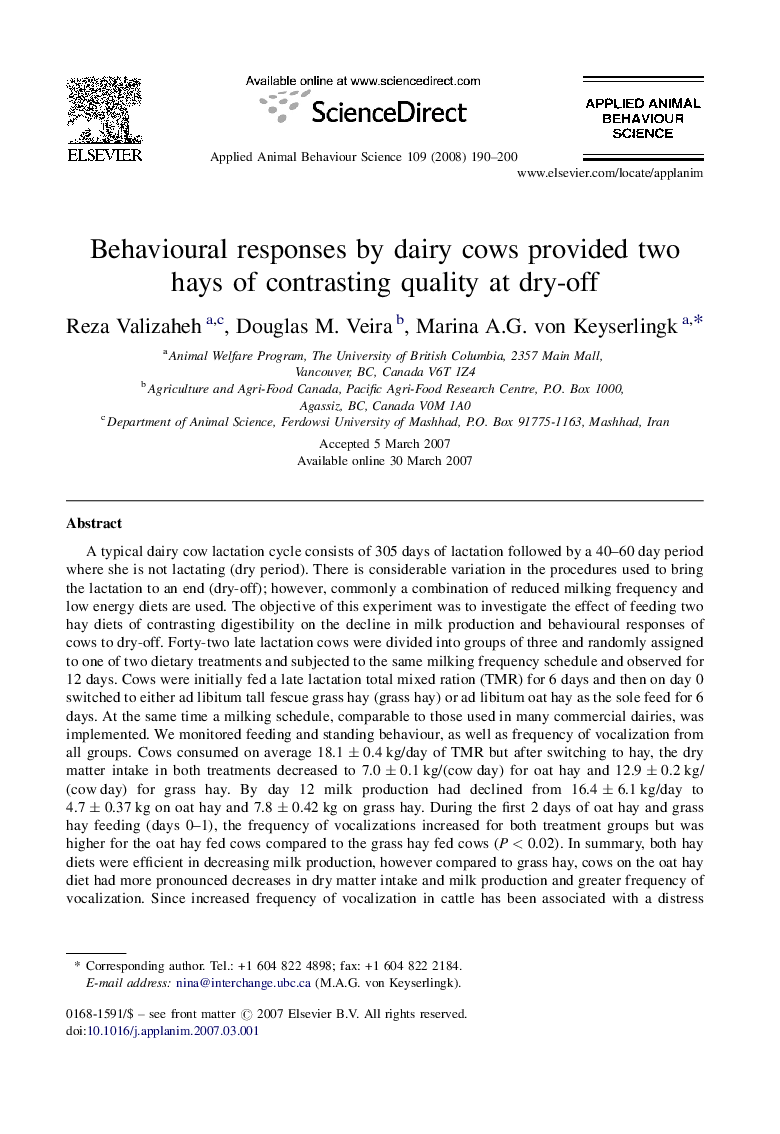| کد مقاله | کد نشریه | سال انتشار | مقاله انگلیسی | نسخه تمام متن |
|---|---|---|---|---|
| 6379761 | 1625426 | 2008 | 11 صفحه PDF | دانلود رایگان |
عنوان انگلیسی مقاله ISI
Behavioural responses by dairy cows provided two hays of contrasting quality at dry-off
دانلود مقاله + سفارش ترجمه
دانلود مقاله ISI انگلیسی
رایگان برای ایرانیان
کلمات کلیدی
موضوعات مرتبط
علوم زیستی و بیوفناوری
علوم کشاورزی و بیولوژیک
علوم دامی و جانورشناسی
پیش نمایش صفحه اول مقاله

چکیده انگلیسی
A typical dairy cow lactation cycle consists of 305 days of lactation followed by a 40-60 day period where she is not lactating (dry period). There is considerable variation in the procedures used to bring the lactation to an end (dry-off); however, commonly a combination of reduced milking frequency and low energy diets are used. The objective of this experiment was to investigate the effect of feeding two hay diets of contrasting digestibility on the decline in milk production and behavioural responses of cows to dry-off. Forty-two late lactation cows were divided into groups of three and randomly assigned to one of two dietary treatments and subjected to the same milking frequency schedule and observed for 12 days. Cows were initially fed a late lactation total mixed ration (TMR) for 6 days and then on day 0 switched to either ad libitum tall fescue grass hay (grass hay) or ad libitum oat hay as the sole feed for 6 days. At the same time a milking schedule, comparable to those used in many commercial dairies, was implemented. We monitored feeding and standing behaviour, as well as frequency of vocalization from all groups. Cows consumed on average 18.1 ± 0.4 kg/day of TMR but after switching to hay, the dry matter intake in both treatments decreased to 7.0 ± 0.1 kg/(cow day) for oat hay and 12.9 ± 0.2 kg/(cow day) for grass hay. By day 12 milk production had declined from 16.4 ± 6.1 kg/day to 4.7 ± 0.37 kg on oat hay and 7.8 ± 0.42 kg on grass hay. During the first 2 days of oat hay and grass hay feeding (days 0-1), the frequency of vocalizations increased for both treatment groups but was higher for the oat hay fed cows compared to the grass hay fed cows (P < 0.02). In summary, both hay diets were efficient in decreasing milk production, however compared to grass hay, cows on the oat hay diet had more pronounced decreases in dry matter intake and milk production and greater frequency of vocalization. Since increased frequency of vocalization in cattle has been associated with a distress response, these findings suggest the oat hay fed cows may be experiencing some distress during the dry-off procedure, perhaps due to hunger.
ناشر
Database: Elsevier - ScienceDirect (ساینس دایرکت)
Journal: Applied Animal Behaviour Science - Volume 109, Issues 2â4, February 2008, Pages 190-200
Journal: Applied Animal Behaviour Science - Volume 109, Issues 2â4, February 2008, Pages 190-200
نویسندگان
Reza Valizaheh, Douglas M. Veira, Marina A.G. von Keyserlingk,